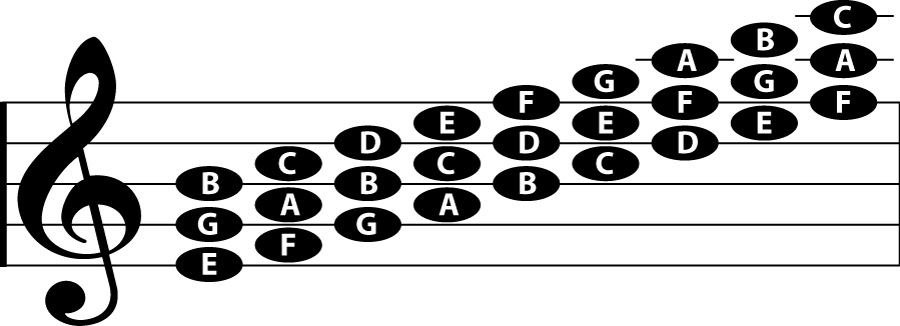Music Staff, Notes on the Staff
5 Line Staff and Notes
In order to understand a key signature as diagrammed in the Circle of Fifths, you'll need to know and understand the musical staff. Tablature is another method of documenting a musical piece for guitar that does not use the 5 line staff. It does not require the ability to read music or understand the musical staff, but I suggest you spend a little time and master the musical staff.
The musical staff consists of 5 horizontal lines as shown in the diagram below. Each line represents a note, and each space in between the lines represents a note. The clef is a symbol used to denote the pitches of the notes in the staff. There are numerous clefs, but most prevalent are Bass and Treble clefs. In each clef, the notes represented by the lines and spaces are different because the instrumets playing the music in any given clef have a musical range that centers comfortably within the staff. For example, Bass clef is used for instruments that play primarily in the lower registers and Treble Clef is for instruments that play primarily in the upper registers.
For this example we will use the Treble Clef, in which guitar music is written. The notes represented by the lines, from bottom to top, are E - G - B - D - F. One common mnemonic device used to remember these notes in sequence is "Every Good Boy Does Fine." The first letter of each word being the line/note from bottom to top. Notice that each line skips one note. The notes that they skip, F - A - C - E, are represented by the spaces in between the lines.

Types of Triads
Take any three adjacent lines (E-G-B, G-B-D, B-D-F etc.) and you have a triad, or chord.Take any three adjacent spaces (F-A-C, A-C-E, C-E-G etc.) and you also have a triad/chord. There are four different types of Triads:
- Major Triad
- Minor Triad
- Diminished Triad
- Augmented Triad
In the diagram below, we will for this example assume that we are in the key of C because there are no sharps or flats in the key signature (see: Circle of Fifths).

